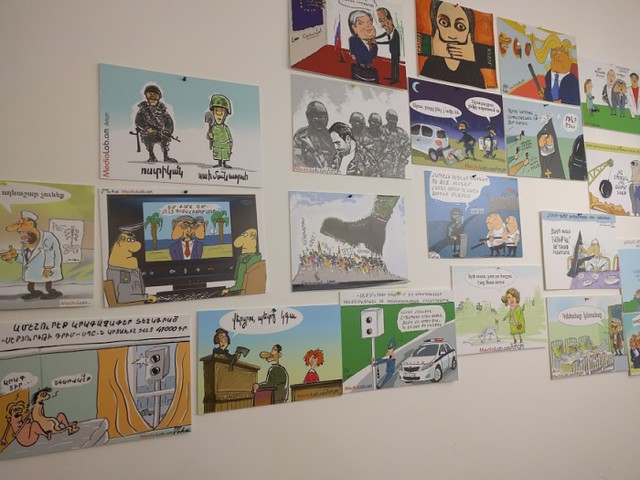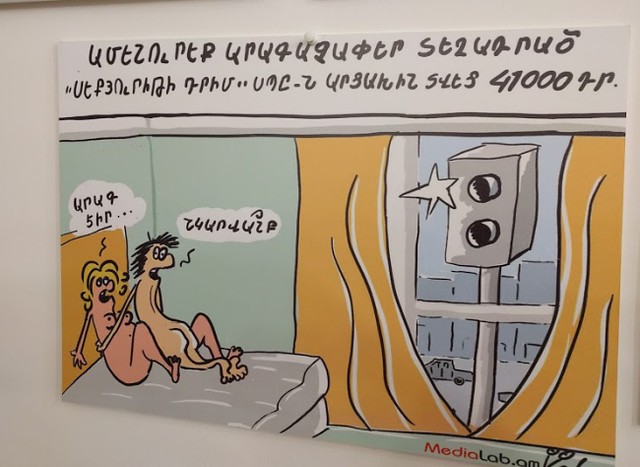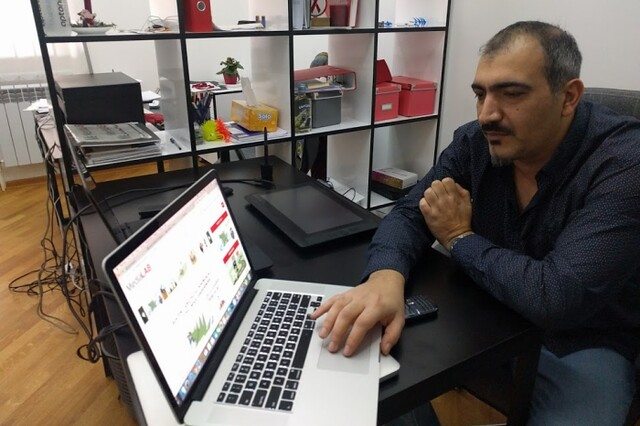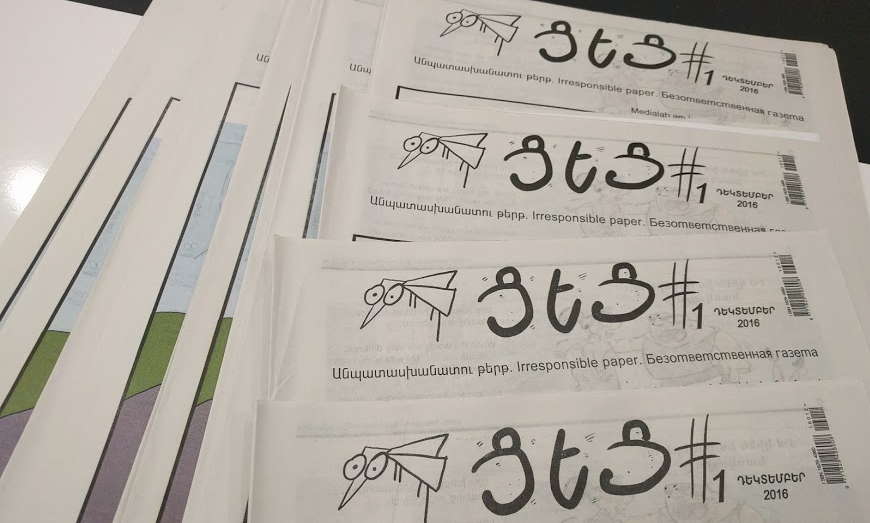A new satirical newspaper, called Moth («Ցեց»), will enter the Armenian media field. The first issue of the newspaper consists exclusively of political cartoons and accompanying text in three languages (Armenian, English, and Russian). Ten thousand copies of the newspaper will be printed. However, there are some obstacles related to newspaper circulation.
Before the launch of the newspaper, political cartoons were being uploaded on the MediaLab website and existed solely in the virtual space.
The editor of MediaLab and Moth, Marianna Grigoryan says, “We realized that we need to go offline. Even if some people believe that print has lost its power to digital, we have decided to have a print newspaper.”

Initially, it was planned to publish the newspaper twice a month, but when the issue of circulation arose, we decided to publish it on a monthly basis. “We do have money for publishing; we’re financed by a political cartoon development project, however, it is difficult to find circulation mechanisms,” says Marianna.
The Municipality denied permission to freely circulate the newspaper in public transport (the way Traveller newspaper is circulated) with the following explanation:
“Since placement of the political cartoon newspaper in public transport and metro stations might cause discontent among passengers and seem offensive to some people, we deem the request inappropriate.”
The concern on dangers of discontent is, honestly, quite amusing. After all, many newspapers publish useless and harsh content that might as well be a cause for discontent. Reading political campaigns might also be disconcerting for people. However, none of that was considered and somehow the unalienable right of passengers to be content become a priority.
The cartoonist at Moth newspaper, Vahe Nersesyan comments on the decision, “One can speculate that the passengers will argue around the issues, maybe there will even be a fist fight among pro-government and pro-opposition passengers. The funny thing is, you won’t find many pro-government people in public transport because they mainly drive around in big, comfortable cars.”

Marianna Grigoryan says that when they came to realize that free circulation is not feasible, a decision was made to sell the newspaper. “In order not to break the law, we registered a limited company and came up with an affordable price of 190 drams for a copy.”
The creators of the newspaper want to make it accessible for people who don’t have the Internet. We even came up with an idea to hire people to sell the newspaper in the city streets.
“Press Stand LLC, a press distribution network in Armenia, asked for a high membership fee and commissions, so we thought to give that money to booksellers and make the circulation process more transparent and public,” says Marianna.
An eight-page newspaper has a section that invites readers to color and to fill in the blanks.
As a rule, the Moth cartoons model real events, as they take place. Minimal context is provided; the focus is on “in-your-face” display of actual events.

“It’s a matter of style. There are cartoonists, whose work resembles a riddle. In other words, you need to look at it for a few seconds, before you discover the hidden meaning. I prefer to turn a spoken word into a cartoon. In my case, a cartoon becomes a quote or a citation,” says Nersesyan.
Marianna Grigoryan believes that political cartoons are not intended to make people laugh as much as they are intended to present a situation from a different perspective, often a shocking one.
For Vahe Nersesyan, a cartoon genre resembles that of a tragicomedy, where a laughter is inseparable from a cry. “Sometimes a cartoon doesn’t make people laugh or smile, but it creates a resonance. Making people laugh does not become an aim in itself. However, a funny cartoon is better remembered,” commented Nersesyan.
There are 5-6 cartoonists working with the newspaper. All of them have a unique style and approach. Marianna Grigoryan mentions that some of the artists stopped working with them because of the pressure. “We had a cartoonist, based in Poland, who had to stop working with us because their family in Armenia was getting threats.”
In the past year, MediaLab staff received curses from the Armenian Apostolic Church, their website was attacked. Last summer, unidentified people broke into the car of the editor and stole cartoon print outs.
A political cartoon cannot be well-received by everybody. Ideally, it is well-received by a subject it portrays. After all, a cartoon cannot be stopped by forbidding, but it can be stopped by an adequate response. Filing a lawsuit against a cartoonist is acceptable. Ignoring a cartoon is acceptable. The only thing not acceptable is forbidding it.
In Armenia, media outlets are mostly loyal to the government. Even scandalous investigations do not change that situation.
The problem is that when a newspaper (even the most successful one) is forbidden to use a certain style or words, the safe space for free speech shrinks in size. A small private newspaper cannot shake the foundations of a state, even when it makes fun of the country’s officials. People who believe otherwise don’t have trust in the government. Interestingly, those are mostly people in power.
The cartoons are not always successful, tastefully done or even funny. That doesn’t matter because a small private initiative obviously cannot compete with giant media holdings. It simply adds another color to our everyday life. If you don’t like it, you don’t have to read it, but remember that color diversity strengthens the eye and makes our life richer.
As world-renowned cartoon newspapers say, we are not afraid to be evil and stupid.

Unlike journalism, with a political cartoon newspaper, it is hard to remain objective and maintain balance. A political cartoon belongs to a free genre, and if you find yourself affiliated with any political group, you will soon realize that your hands are tight and you cannot work,” says Marianna Grigoryan.
The Moth cartoons are based on actual events. In order to understand them, you need to be aware of political developments. If you don’t follow politics, the cartoons won’t tell you much.
“All images are accompanied by comments. In fact, we spread awareness, similar to reporters writing news pieces. We see us more as newsmakers. For example, we have a cartoon on purchases of the National Security Service (17 tons of sugar and 7 tons of margarine). First of all, we verified that astonishing piece of information just like reporters do, seeking out sources and evidence. Then, we created two cartoons to inform and spread awareness among people.
“With cartoons, you are also allowed to use unverified news and gossips,” says Vahe Nersesyan. A news article works differently from a cartoon. The impact of a cartoon is more immediate. “There are many cartoons in Armenia but, unfortunately, they mostly target Azerbaijan and Turkey. I believe there is a fear when it comes to targeting inner issues of the country,” comments Marianna Grigoryan.
In addition to cartoons, the newspaper intends to create comic series, along with gifs and animation shorts. In this case, they can create an honest and honorable character. The newspaper has many wishes and ideas. One thing for sure, it should start with blunt political cartoons.
“If people don’t have time to read long articles but they are concerned with the reality, the best way to inform and involve them in learning about political developments is comic series,” says Marianna Grigoryan.
Commenting on the name of the newspaper, Vahe Nersesyan explains, “A moth is seen as a pest, it doesn’t do anything useful. A bee can sting you but it is a useful insect. The same is true for a broom, it is used for sweeping. We want for people, targeted by the newspaper, to see the humor of the situation and take it easy. That culture has to develop. You might have noticed that our cartoons don’t insult people, they make fun of absurd situations. After all, all of our characters are political figures. Often, people and discourses in politics are so vulgar that there is no need to aggravate that any further.”
Humour is always contradictory. With Moth cartoons, it’s obvious that behavior and speech of our political elite contradict our social norms. When people say it’s not okay to joke about certain things, that becomes a very convenient filter for those in power.
Proponents of moral taboos miss an important point: in order to be funny, people and events need to be taken off their pedestals, in other words, things need to be turned around, upside down and inside in.
And for that to happen, we need to strive for media diversity across various genres, including humor.
Nune Hakhverdyan







